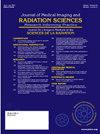用于脑肿瘤患者立体定向放射治疗的双壳定位系统的固定精度。
IF 1.3
Q3 RADIOLOGY, NUCLEAR MEDICINE & MEDICAL IMAGING
Journal of Medical Imaging and Radiation Sciences
Pub Date : 2024-12-13
DOI:10.1016/j.jmir.2024.101817
引用次数: 0
摘要
导言:与金标准的有创刚性框架系统相比,无创框架系统为立体定向放射治疗铺平了道路,因为它们让患者感觉舒适,没有疼痛、出血、感染、框架滑动的风险,并且具有相似的治疗效果:目的和方法:对使用双壳定位系统(DSPS)在脑肿瘤患者中进行立体定向放射治疗时的固定精确度(牵引间和牵引内)和PTV边缘进行估算:对19名KPS≥70的颅脑肿瘤患者进行了前瞻性研究,这些患者使用双壳定位系统(DSPS)固定,并用嘴咬合,接受基于LINAC图像引导的立体定向放射治疗。PTV距肿瘤2毫米。通过将治疗室的激光对准 DSPS 上标记的等中心,对患者进行定位。对所有患者进行三维图像配准(自动骨骼解剖),方法是将第1次CBCT图像与模拟参考CT(simCT)图像进行匹配,以便在每天进行治疗前测量三维目标位移。以毫米为单位的初始设置偏差/牵引运动-平移(内侧-外侧-X、头颅-尾侧-Y、前方-后方-Z)位移和以度为单位的旋转轴(俯仰、滚动、偏航)位移都被记录下来。所有过渡误差均在线校正。对于残余的屈光间运动,在纠正初始设置错误后进行第二次 CBCT 扫描,并与模拟 CT 和执行的治疗相匹配。为了评估分段内运动,在每个分段结束时进行 CBCT 扫描,并与第二次 CBCT 图像进行比较。计算系统误差和随机误差,并使用 van Herk 公式估算计划目标容积(PTV)边缘:结果:共评估了 95 组 CBCT 图像数据。初始设置迁移精度--X、Y、Z 三个方向的平移位移平均值(±SD)分别为 1.2 (0.6)、1.0 (0.9)、0.5 (0.6) 毫米,俯仰、滚动和偏航的旋转分别为 0.6 (± 0.5)、0.1 (± 0.4)、0.60 (± 0.6) 度。校正后,X、Y 和 Z 方向的残余折射平均位移分别为 0.1(± 0.3)、0.2(± 0.6)和 0.3(± 0.4)毫米。总体系统和随机平移误差分别为 0.2、0.3、0.3 和 0.6、0.4、0.4。在分区内运动方面,X、Y 和 Z 轴的平均(±SD)位移分别为 0.3(±0.2)、0.3(±0.5)和 0.4(±0.2)毫米,所有轴的旋转都很小。分区内群体系统误差和随机误差均为结论:使用图像引导的无框架嘴咬合 DSPS 系统在颅脑肿瘤的立体定向治疗中实现了毫米级的设置精度,且分量内运动在亚毫米级。为今后接受脑立体定向治疗的患者减少了1.1毫米的PTV边缘。本文章由计算机程序翻译,如有差异,请以英文原文为准。
Immobilisation accuracy of double shell positioning system for stereotactic radiotherapy in patients with brain tumors
Introduction
Non-invasive frameless systems have paved its way for stereotactic radiotherapy treatments compared to gold standard invasive rigid frame-based systems as they are comfortable to patients, do not have risk of pain, bleeding, infection, frame slippage and have similar treatment efficacy.
Aim and objective
To estimate immobilisation accuracy (interfraction and intrafraction) and PTV margins with double shell positioning system (DSPS) using daily image guidance for stereotactic radiotherapy in patients with brain tumors.
Materials and method
A prospective study was done in 19 cranial tumor patients with KPS ≥70, immobilized by the DSPS with mouth bite and treated with LINAC based image guided stereotactic radiotherapy. A PTV of 2 mm was given from the tumor. Patients were positioned by aligning the treatment room lasers to the marked isocentre on the DSPS. For all patients 3D-image registration (automatic bony anatomy) was performed by matching 1st CBCT images with the simulation reference CT (simCT) images to measure the 3D target displacement prior to the treatment delivery every day. The initial setup deviation/ interfraction motion- translational (medio-lateral-X, cranio-caudal-Y, anterior-posterior-Z) displacements in mm and rotational axis (pitch, roll, yaw) in degrees were documented. All transitional errors were corrected online. For residual Interfraction motion a 2nd CBCT was done after correction of initial setup errors and matched with simCT and treatment executed. To evaluate the intrafraction motion CBCT was done at end of every fraction and compared with 2nd CBCT images. Systematic and random errors were calculated and planning target volume (PTV) margins were estimated using van Herk formula.
Results
A total of 95 CBCT image data sets were evaluated. The initial setup relocation accuracy -mean (±SD) displacements for translational X, Y and Z directions were 1.2 (0.6), 1.0 (0.9), 0.5 (0.6) mm respectively and rotations were 0.6 (± 0.5), 0.1 (± 0.4), 0.60 (± 0.6) degrees for pitch, roll and yaw respectively. Post correction, the residual interfraction mean displacements in X, Y and Z directions were 0.1 (± 0.3), 0.2 (± 0.6), 0.3 (± 0.4) mm respectively. The population systematic and random translational errors were 0.2, 0.3, 0.3 and 0.6, 0.4, 0.4 respectively. For intrafraction motion, the mean (±SD) displacements were 0.3 (± 0.2), 0.3 (± 0.5), 0.4 (± 0.2) mm in X, Y and Z directions respectively with minimal rotations in all axis. The intrafraction population systematic and random errors were <0.5 mm for all displacements. The online corrections decreased the interfraction PTV margins to 1.1, 1.1 and 1.2 mm in X, Y and Z directions respectively.
Conclusion
Frameless DSPS system with mouth bite using image guidance achieved a setup accuracy of a millimeter for stereotactic treatment in cranial tumors with submillimeter intrafraction motion. A decrease in PTV margins of 1.1 mm was achieved for future patients undergoing brain SRT.
求助全文
通过发布文献求助,成功后即可免费获取论文全文。
去求助
来源期刊

Journal of Medical Imaging and Radiation Sciences
RADIOLOGY, NUCLEAR MEDICINE & MEDICAL IMAGING-
CiteScore
2.30
自引率
11.10%
发文量
231
审稿时长
53 days
期刊介绍:
Journal of Medical Imaging and Radiation Sciences is the official peer-reviewed journal of the Canadian Association of Medical Radiation Technologists. This journal is published four times a year and is circulated to approximately 11,000 medical radiation technologists, libraries and radiology departments throughout Canada, the United States and overseas. The Journal publishes articles on recent research, new technology and techniques, professional practices, technologists viewpoints as well as relevant book reviews.
 求助内容:
求助内容: 应助结果提醒方式:
应助结果提醒方式:


